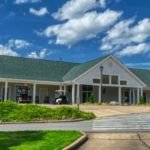Voice Your Questions with Jeff Meek: Episode 3 Jason Temple
On June 11, 2019, Managing Editor of Hot Springs Village Voice, Jeff Meek, interviewed Hot Springs Village Property Owners’ Association Chief Operating Officer, Jason Temple. Meek asked Temple questions submitted by the Villagers. Below is a synopsis of the interview:
Melinda Alvord
Melinda Alvord: Who’s responsible for cleaning the monument signs at the subdivision entrances?
Jason Temple: Temple was unsure but thought possibly the neighborhoods had their own groups to maintain the subdivisions. He has not heard of the grounds maintenance doing this. He will find out more information on this subject and feels that the folks that do maintain the subdivision signs do a great job.

Frank Leeming
Frank Leeming: What happened to the crack sealing machine authorized by the Board of Directors in 2013? What roads and how many miles will be repaved this year?
Jason Temple: The crack sealing machine was purchased two years ago. This year we have 14 ½ miles that we have contracted out to be sealed. The POA is going to be working on crack sealing all the parking lots for the golf courses and parks and recreation facilities. When the crew is “up to speed” they will start doing more residential roads. The goal is to do some type of road treatment, up to 30 miles every year. Half is being treated with crack sealant and some will be treated with micro surfacing which is a thin overlay. The rest of the work will consist of pothole repairs. There are no major road overlays planned for this year. There will be some paving done in small subdivisions.
Walter Chance
Walter Chance: Will the committee consider making Carmona and Desoto a four-way stop?
Jason Temple: They will consider doing that. They are doing warrant studies which look at a series of conditions which are the amount of traffic, accidents, and turns. If it meets the engineering standard then we can say, “this warrants us doing that”. Converting intersections to four-way stops has to be done with caution as accidents could occur since it is a change for the driver. This change must be well publicized in order to avoid additional accidents caused by the change.
Walter Chance: Who inspects the sewer plant and what is the capacity of the sewer plant?
Jason Temple: We have two sewer plants and each are rated as one million gallons per day of capacity. Arkansas Department of Environmental Quality (ADEQ) gives us permits for both wastewater treatment plants. ADEQ does yearly inspections. If there are any deficiencies, they let us know and then we do what is needed to be in compliance. We just received a letter saying we are in good standing.
Jeff Meek
Jeff Meek: Excessive copper in the water was a past issue and it was a mystery as to where this excessive copper was coming from.
Jason Temple: Both wastewater treatment plants were permitted to have only 10 parts per billion of copper in the discharge. “We get copper out of Middlefork Creek that goes to Lake Lago and goes into our water system.” This results in the copper level being 10 to 15 parts per billion. The water then goes into people’s homes and because of the copper tubing and other factors the untreated water comes back into the plant somewhere between 50 and 80 parts per billion which must be removed at the wastewater treatment plants. It is not easy to remove copper. To deal with this, we have a two-phase approach.
- We approached ADEQ about raising our allowable copper limits on the permit. This is presently in the works.
- The second approach was determining how to treat the copper. We found a chemical that can be added which allows heavy metals to precipitate. The metals are transformed from a solid state to a physical precipitant that will fall out. Since using this chemical, we have been compliant in regards to copper this whole year and may not need our copper allowances raised.
Jeff Meek: What happens to the waste product?
Jason Temple: says the technical term is biosolids and these are hauled to the landfill in Saline County. The biosolids are about 85 percent liquid and 15 percent solid. They are working on a way to turn all of this into fertilizer in order to have a greener operation and cut costs.
Walter Chance
Walter Chance: Are there funds available to develop additional turning lanes on Desoto?
Jason Temple: There are not any funds budgeted this year for additional turning lanes. Jason added that this would be a great approach to do this to any of the intersections that are changed into four-way stops and doing both of these things together would be a safer way to go about it. By “creating a construction activity event” it trains drivers to slow down.
Thomas Pepper
Thomas Pepper: What is the current percentage of fresh water loss that occurs in HSV’s water distribution system?
Jason Temple: It takes a lot of data to figure that out. Because we read meters every two months, the data is more difficult to calculate. We stand around 30 to 35 percent water loss and the goal is to get to 25 percent water loss. “We think that is a reasonable percentage of water loss given the huge size of our water utility. We are a fifteen-mile water utility with thousands of miles of water lines which have joints every 20 feet. Cities usually try to not go over 15 percent but cities are much smaller. We are 55 square miles and a city around here is six to ten square miles.
If we were able to read all the water meters in the Village at the same time that we read the production meter from the water plant, we could come up with a very accurate figure for water loss. Because of this, we must look at the annual numbers which show us in the 30 to 35 percent water loss range.
When we eventually change out the meters to automatic meter read, it will be much easier to calculate the water loss and also determine where the leaks are located.
Sam Taylor
Sam Taylor: “We’ve heard a lot about culvert replacement and the high cost of replacement. What is the plan for this maintenance project and secondarily how is it determined which ones are up for replacement or maintenance?”
Jason Temple: “We just recently completed a GPS of every single culvert here in the Village.” Culverts are located at 3,700 sites. These sites may have multiple culverts. We have counted 3,789 culverts. All these culverts were rated on a scale of one to five with one meaning it needs to be replaced and a score of five means it is in good shape. Also, comments were made for each culvert as to the details of what was needed. About 39 percent of the Village culverts need some attention. Planning for how to tackle this is in progress. “How do we fund this? How do we finance this? How do we spread this out over the next couple of years?” There will be more information regarding this in the future.
Sam Taylor: When did the last increase occur for water rates?
Jason Temple: The last water rate increase was a year ago. We did not increase in 2019. The plan was to increase two to three percent a year from here on out. Previously the BOD approved around a seven to ten percent water and sewer rate increase for about three straight years.
Jason feels that everyone had their priorities straight by approving these increases because “everybody knows, if the water doesn’t come out of your faucet, what’s the point? And if you can’t flush your toilet, what’s the point?”
Cheryl Dowden
Cheryl Dowden: The Balboa Club has been in need of repair for several years. Presently, are there any plans in the works to restore Balboa Club to its former glory and if so, what are these plans?
Jason Temple: That question was out of Jason’s purview but he wants to see the Balboa Club restored. I have high confidence we will figure something out to repurpose that building or restore that building or remodel that building in a way that will continue to benefit the grandeur of that area as well as the Village.”
Perry
Perry: How will the street repairs in the Village be paid for? Will we use local, state or federal funds or raised assessments?
Jason Temple: Everything in the Village is funded by property owners through assessments.
On June 25, 2019, Jeff Meek will be interviewing Cindi Erickson
Synopsis by Cheryl Dowden, Published June 12, 2019












recommended financial advisors
07/30/2019 — 3:55 pm
Hey there, You’ve performed an incredible job. I will definitely digg it and personally recommend to my friends. I’m sure they’ll be benefited from this site.